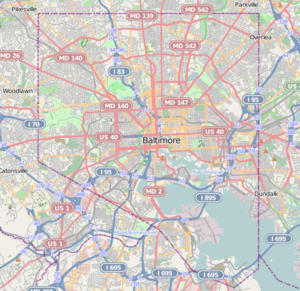St. Francis Xavier Church (Baltimore, Maryland)
St. Francis Xavier Church is a parish church of the Roman Catholic Archdiocese of Baltimore located in Baltimore, Maryland. The church was popular with the elite class of African-Americans in Baltimore and it claims to be the "first Catholic church in the United States for the use of an all-colored congregation."[1]
| St. Francis Xavier Church | |
|---|---|
 St. Francis Xavier Church | |
| Location | 1501 E. Oliver Street, Baltimore, Maryland |
| Country | United States |
| Denomination | Roman Catholic |
| Website | St. Francis Xavier Church |
| History | |
| Founded | 1863 |
| Founder(s) | Black San Domingo refugees and the Sulpician Fathers |
| Dedication | Francis Xavier |
| Dedicated | February 21, 1864 |
| Consecrated | |
| Architecture | |
| Functional status | Active |
| Heritage designation | For African-American Roman Catholics |
| Architectural type | Church |
| Groundbreaking | |
| Completed | |
History
The St. Francis Xavier Church was purchased on October 10, 1863, and dedicated on February 21, 1864. The founders of the church were Black Catholic refugees from San Domingo and their descendants, along with the Sulpician Fathers. The Sulpician Fathers had fled France in 1790 as refugees of the French Revolution and were affiliated with St. Mary's Seminary. On July 11, 1791, six ships from the French fleet arrived at Fell's Point, Baltimore, bringing a large number of Black Roman Catholic refugees from Cape Francois in the French colony of San Domingo. There were between 500 and 1,000 Black refugees, both slaves and free. The majority of the free Black refugees were educated and wealthy. When the Black refugees first settled in Baltimore they attended Mass in the basement of St. Mary's Seminary. Both the Sulpicians and the Haitian refugees spoke French. In 1828, Haitian women refugees founded the Oblate Sisters of Providence, a Catholic religious institute for African-American women. The Oblate Sisters were the first all-Black order of Roman Catholic nuns.[2]
St. Francis Xavier's remains an African American parish and is affiliated with both the Jesuits and the Josephites.[3]
See also
- Josephite Fathers
- Society of Saint-Sulpice
References
- Gatewood, Willard B. (1990). Aristocrats of Color: The Black Elite, 1880-1920. Bloomington, Indiana: Indiana University Press. p. 306. ISBN 1-55728-593-4. Retrieved August 29, 2012.
- Smith, Jessie Carney (2006). Encyclopedia of African American Business, Volume 1. Westport, Connecticut: Greenwood Publishing Group. p. 474. ISBN 0-313-33110-3. Retrieved August 29, 2012.
- "Archdiocese of Baltimore National Parishes" (PDF). St. Mary's Seminary and University. Archived from the original (PDF) on 2013-12-02. Retrieved 2012-08-23.
